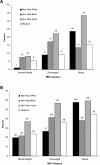Prevalence and control of diabetes and impaired fasting glucose in New York City
- PMID: 19114627
- PMCID: PMC2606831
- DOI: 10.2337/dc08-0727
Prevalence and control of diabetes and impaired fasting glucose in New York City
Abstract
Objective: To determine the prevalence of diabetes and impaired fasting glucose (IFG) and to assess clinical management indicators among adults with diabetes in a representative sample of New York City adults.
Research design and methods: In 2004, New York City implemented the first community-level Health and Nutrition Examination Survey (NYC HANES), modeled after the National Health and Nutrition Examination Survey (NHANES). We used an interview to determine previously diagnosed diabetes and measured fasting plasma glucose to determine undiagnosed diabetes and IFG in a probability sample of 1,336 New York City adults. We assessed glycemic control and other clinical indicators using standardized NHANES protocols.
Results: The prevalence of diabetes among New York City adults was 12.5% (95% CI 10.3-15.1): 8.7% diagnosed and 3.8% undiagnosed. Nearly one-fourth (23.5%) of adults had IFG. Asians had the highest prevalence of impaired glucose metabolism (diabetes 16.1%, IFG 32.4%) but were significantly less likely to be obese. Among adults with diagnosed diabetes, less than one-half (45%) had A1C levels <7%; one-half (50%) had elevated blood pressure measures at interview, 43% of whom were not on antihypertensive medications; nearly two-thirds (66%) had elevated LDL levels, and only 10% had their glucose, blood pressure, and cholesterol all at or below recommended levels. Most adults (84%) with diagnosed diabetes were on medication, but only 12% were receiving insulin.
Conclusions: In New York City, diabetes and IFG are widespread. Policies and structural interventions to promote physical activity and healthy eating should be prioritized. Improved disease management systems are needed for people with diabetes.
Figures


Comment in
-
New York City Health and Nutrition Examination Survey: a model for urban health surveillance.Diabetes Care. 2009 Jan;32(1):204-5. doi: 10.2337/dc08-1807. Diabetes Care. 2009. PMID: 19114628 Free PMC article. No abstract available.
-
Prevalence and control of diabetes and impaired fasting glucose in New York City: response to Thorpe et al.Diabetes Care. 2009 May;32(5):e62; author reply e63. doi: 10.2337/dc09-0129. Diabetes Care. 2009. PMID: 19407072 No abstract available.
References
-
- Cowie CC, Rust KF, Byrd-Holt DD, Eberhardt MS, Flegal KM, Engelgau MM, Saydah SH, Williams DE, Geiss LS, Gregg EW: Prevalence of diabetes and impaired fasting glucose in adults in the U.S. population: National Health And Nutrition Examination Survey 1999–2002. Diabetes Care 29:1263–1268, 2006 - PubMed
-
- Geiss L, Pan L, Cadwell B, Gregg E, Benjamin S, Engelgau M: Changes in Incidence of Diabetes in US Adults, 1997–2003. Am J Prev Med 30:371–377, 2006 - PubMed
-
- The DECODE study group on behalf of the European Diabetes Epidemiology Group: Glucose tolerance and mortality: comparison of WHO and American Diabetes Association diagnostic criteria. Lancet 354:617–621, 1999 - PubMed
-
- Barr ELM, Zimmet PZ, Welborn TA, Jolley D, Magliano DJ, Dunstan DW, Cameron AJ, Dwyer T, Taylor HR, Tonkin AM: Risk of cardiovascular and all-cause mortality in individuals with diabetes mellitus, impaired fasting glucose, and impaired glucose tolerance: the Australian Diabetes, Obesity, and Lifestyle Study (AusDiab). Circulation 116:151–157, 2007 - PubMed
-
- Kanjilal S, Gregg EW, Cheng YJ, Zhang P, Nelson DE, Mensah G, Beckles GLA: Socioeconomic status and trends in disparities in 4 major risk factors for cardiovascular disease among US adults, 1971–2002. Arch Intern Med 166:2348–2355, 2006 - PubMed
MeSH terms
Substances
LinkOut - more resources
Full Text Sources
Medical

